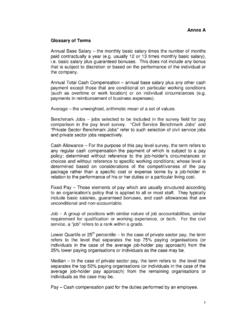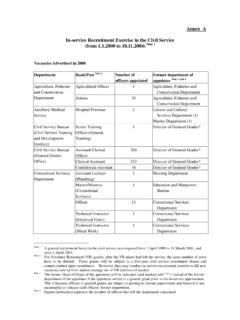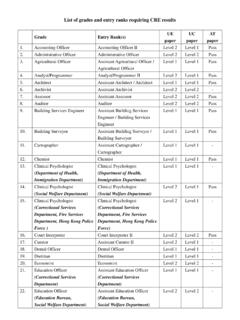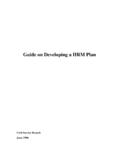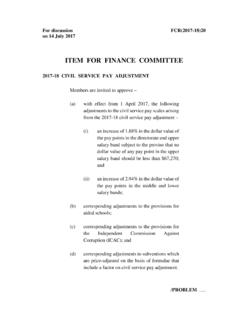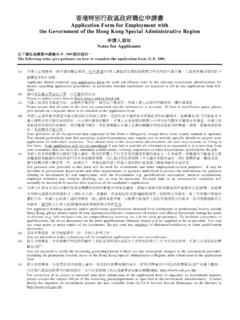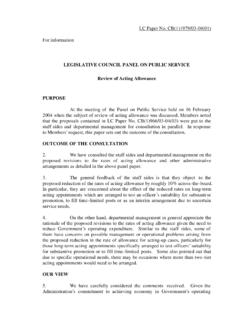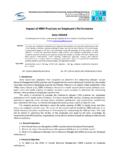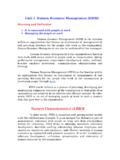Transcription of Guide on Developing a HRM Plan - csb.gov.hk
1 Guide on Developing a HRM PlanCivil Service BranchJune 1996 Table of ContentsIntroductionWhat is a HRM Plan?Critical Success Factors for Developing the HRM PlanA Shift in MindsetThe HRM Plan in ContextModel for Developing the HRM PlanDeveloping a HRM Plan - A Step-by-Step ApproachStep 1 -Conduct a Departmental Strategic AnalysisStep 2 - Identify Strategic HR IssuesStep 3 - Identify Ongoing HR IssuesStep 4 - Prioritize the HR Issues and Determine ActionsStep 5 - Draw up the HRM PlanSamples of a Summary List of hrm Programmes and a HRM Plan ProgrammeIntroductionThe purpose of this Guide is to provide practical help to departments in their effort todevelop a Human Resource Management (HRM) Plan. This Guide outlines theconceptual model adopted, describes the procedures to be followed and illustrates theprocedures by examples from is a HRM Plan?HRM is a strategic and systematic approach to managing people in a way that wouldmaximise their motivation and contribution towards meeting the organisation sobjectives.
2 A HRM Plan is a departmental document which sets out what programmesare required in the following few years to practise HRM in the department. The aim ofa HRM Plan is to help the department to achieve its mission and objectives through asystematic design and implementation of hrm Success Factors for Developing the HRM PlanWhether the HRM Plan can achieve its desired purpose depends on:l Top management commitment to the philosophy that people are the key to thesuccess in achieving the objectives of the Strategic linkage of the department's HRM programmes to its mission Line management's ownership of the HRM Shift in MindsetDeveloping a HRM Plan calls for a shift in the way people are managed in thedepartment : from administering people to achieving departmental strategic objectivesthrough people. The following table illustrates this shift :Administrative FocusHRM FocusAdministering personnel policiesHelping to achieve strategic goals throughpeopleStand alone programmes in management ofpeopleHRM programmes integrated withbusiness plansPriorities in managing people often linkedto the latest management concepts andideasHRM priorities linked to businessprioritiesPersonnel units responsible formanagement of peopleLine managers and personnel units sharejoint responsibility for HRMThe HRM Plan in ContextBoth departments and the Civil Service Branch have a role to play in the development ofHRM Service Branch:Strategic Direction : To develop and promote service-wide policies, standards and goodpractices in the management of human Functions : To advise departments on the implementation of policies and on thedevelopment of their HRM.
3 To develop the department's HRM PlanModel for Developing the HRM PlanThe HRM Plan is built upon an understanding of the department's vision, mission, values,and strategic programmes and challenges. Developing the HRM Plan this way links theHRM programmes to business plans and helps prioritize HRM programmes according tobusiness FOR Developing THE HRM PLANV ision, Mission, ValuesStrategic ChallengesStrategic HR IssuesStrategic ReviewOngoing HR IssuesHRM PlanHRM ProgrammesDeveloping A HRM Plan - A Step-by-Step ApproachThe model for Developing the HRM Plan is carried out through 5 steps. While thesesteps can apply to any department, the duration and complexity of each step varies fromone department to another depending on the department's unique situation. Thedevelopment of the HRM Plan can be facilitated either by an internal team or outsideconsultants. In either case, participation of top management and staff representatives isrequired to ensure the HRM Plan meets the needs of the department, is supported byboth the management and staff, and can be implemented within the constraints of Steps in Developing a HRM Plan1.
4 Conduct a departmental strategic analysis: The results of this step are anunderstanding of the department's vision, mission, values; a strategic review of thedepartment; and understanding of the challenges facing the Identify strategic HR issues arising from the strategic analysis: Building on theresults of step one, the outcome of this step is an analysis of the strategic HRissues facing the Identify ongoing HR issues: In addition to the strategic HR issues identified instep two, the ongoing HR issues impacting the department's effectiveness mustalso be Prioritize the strategic and ongoing HR issues and determine actions: Once allthe HR issues have been identified through steps two and three, they should beprioritized and key actions required in respect of each issue identified with inputfrom the department's top Draw up the HRM Plan: Once the department's top management has given theirinput into the HR priority issues and key actions to be taken in step four, the HRMPlan and its associated programmes are ready to be 1 - Conduct a Departmental Strategic AnalysisThe goal of the HRM Plan is to support and reinforce the department's objectives andprogrammes.
5 The first step in Developing the Plan is to obtain a clear understanding ofthe department's objectives, programmes and key challenges. This understanding canbe obtained by conducting a strategic to Dol Conduct a strategic review of the department including strategic objectives,direction and critical success Strategic objectives are departmental objectives which are usually articulatedthrough the vision, mission, values, corporate business plans and strategicprogrammes. If the department's vision, mission and values have not beenarticulated, it is recommended that the opportunity be taken to articulate them asseen in the Drainage Services Department Strategic direction is where the department, and the services it plans to providein the future, are heading Critical success factors are the factors that will determine whether the strategicobjectives will be achieved, if customer satisfaction is an objective, thendelivering services that meet customer expectations is a critical success :l Identify strategic challenges.
6 Strategic challenges consist of both internalchallenges such as internal organizational issues and external challenges such asresponding to changing public a Strategic ReviewCustomer & Excise DepartmentVision & MissionVisionl To be recognized as a CustomsAdministration that provides the highestquality of Customs services with integrityand professionalism in protecting therevenue of Hong Kong, facilitating legaltrade, enforcing Customs laws and fulfillinginternational Customs To perform our Customs duties efficientlyusing the best management, intelligenceand To deliver quality service on the principlesof facilitation, accountability, consistency,transparency and To develop an organizational culture thatrecognizes the importance of staffcontribution and Programmesl Control & Enforcementl Anti-Narcotics Investigationl Intellectual Property Rights &Consumer Protectionl Revenue Protection & Collectionl Trade ControlsExample :Howl Review key departmental documents.
7 These include the department's vision,mission, and values, programmes, and other strategic documents. If the departmenthas not yet formulated its vision, mission and values, it would be useful to have themworked Interview senior departmental staff to obtain their views on the department'sdirection, critical success factors and Interview key departmental stakeholders, members of staff and customers of thedepartment's service to determine their expectations of the ChallengesCustoms & Excise Departmentl Move to Chap Lap Kok Airportl Continuous expansion of passenger and cargo traffic at Hong Kong-Chinaborderl Addition of consumer protection responsibilitiesl Increasing public expectations for service qualityCase StudyDrainage Services DepartmentDevelopment of its Vision, Mission, and ValuesDrainage Services Department (DSD) had already formulated a number of strategic staff were very clear about the scope of their job and responsibilities.
8 However, theDepartment was still in need of a vision and mission, as well as a set of values to Guide and unify theefforts of the whole Department to meet departmental objectives. The DSD senior managementteam decided to develop its statements of vision, mission, and values as a key precursor to itsdepartmental HRM initiated the process by examining anddiscussing the future desired state of theDepartment amongst the senior managementteam in a workshop facilitated by theconsultant. During the workshop, themanagement team was divided into threegroups. Each group drafted vision andmission statements which were presented anddiscussed in the workshop. The team wasable to reach consensus on a draft after thehalf day workshop. Several focus groupswere held to consult staff on the draft vision,mission and value statements.
9 As a result ofsuggestions from staff, the original draftswere process of soliciting and incorporatingfeedback from different groups of staff willcontinue until the majority of staff have beenconsulted. The statements will then befinalized, translated into Chinese andpublicized throughout the its vision and mission formulated, DSDwas able to identify what changes wererequired in the way the Department managedits human resources so that the Departmentwould be better able to achieve its vision Vision, Mission, ValuesDrainage ServicesVision To develop and maintain world-classdrainage systems to keep ourcommunity healthy and are committed to - improving our drainage systems to treatwastewater and dispose of rainwater inan environmentally responsible manner; providing safe, healthy and rewardingworking environment for our staff; delivering an efficient, cost-effective andcourteous service.
10 And fostering good working relationshipswith our clients, consultants Commitment Teamwork ProfessionalismCustomer SatisfactionStep 2 - Identify Strategic HR IssuesOnce a clear understanding of the department's objectives, direction and key challengesis established, the next step in formulating the HRM Plan is to identify the department'sstrategic HR issues. These are the key HR issues that will affect the department'sability to achieve its strategic objectives. The HRM Plan will need to address how tomanage these to Dol Assess the HR implications of the findings of the strategic Identify the department's strategic HR of Strategic Challenges and Strategic HR IssuesCustoms & Excise DepartmentStrategic ChallengesStrategic HR Issuesl Move to Chek Lap Kok Airportl Increase in manpower requirementsl Heavy demand for training for new recruitsl Officers required to spend more time onrecruitment exercisesl Continuous expansion of passengerand cargo traffic at Hong Kong-China borderl Increase in manpower requirementsl Addition of consumer protectionresponsibilitiesl Training to develop new skillsl Increasing public expectations forservice qualityl Need to communicate new servicestandards and assessment methodsl Training on improving service qualityHowl Review the findings of the strategic analysis and list out potential HR implications.
